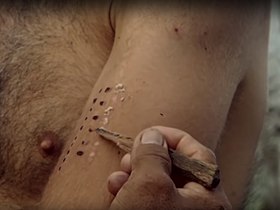This article may lend undue weight to certain ideas, incidents, or controversies. (July 2023) |
| Kambo (drug) | |
|---|---|
 A kambo ceremony: the frog secretion is being applied to the burnt skin. | |
| Alternative therapy | |
| Claims | It is claimed that kambo will help with a number of issues including, depression, anxiety, addiction, fertility, fever, mental clarity, negative energy and the cleansing of the body |
Kambo, also known as vacina-do-sapo, or sapo (from Portuguese: sapo, lit. 'toad'), is the dried skin secretions of the giant leaf frog (known as the kambô in Portuguese), a species of frog, used as a transdermal medicine; however, evidence for its effectiveness is limited.
Kambo is usually used in a group setting, called a kambo circle or kambo ceremony. The effects on humans usually include tachycardia, nausea, vomiting, and diarrhea. A meta-review of 50 studies in which 11 cases of acute intoxication were examined found that extreme cases have included psychosis (occasionally severe), SIADH, kidney damage (including acute renal failure), pancreas damage, liver damage including toxic hepatitis, dermatomyositis, esophageal rupture, and seizures, in some cases leading to death[1][2][3], although such incidents are limited in number and some evidence suggests precipitation by medical contraindications.[4]
Kambo, which originated as a folk medicine practice among some indigenous peoples in the Amazon basin, is also administered as a complementary medicine and alternative medicine treatment in the West, often as a pseudoscientific cleanse or detox. The ceremony involves burning an arm or leg and applying the kambo secretion directly to the burn. Promoters claim that kambo helps with several illnesses or injuries. There is no scientific evidence that it is an effective treatment[5][6][7][a] and causal evidence is limited.[citation needed]
It seems to be particularly dangerous to take kambo with large quantities of water. Doing that is associated with SIADH and severe electrolyte imbalances: changes in plasma and urine osmolarity, hypokalemia, hypomagnesemia and hypophosphatemia. Naloxone is under study as a possible antidote; hospital treatment also includes medicines to protect organs from damage and restore electrolyte function.[1]
- ^ a b Cite error: The named reference
SaccoZibettiBonetta2022was invoked but never defined (see the help page). - ^ Cite error: The named reference
JVATITD2014was invoked but never defined (see the help page). - ^ Cite error: The named reference
DalyCaceres1992was invoked but never defined (see the help page). - ^ Cite error: The named reference
ForensicScience2019was invoked but never defined (see the help page). - ^ Cite error: The named reference
Derma2019was invoked but never defined (see the help page). - ^ Cite error: The named reference
TheGuardian2021was invoked but never defined (see the help page). - ^ Cite error: The named reference
ABCNewsMay2023was invoked but never defined (see the help page).
Cite error: There are <ref group=lower-alpha> tags or {{efn}} templates on this page, but the references will not show without a {{reflist|group=lower-alpha}} template or {{notelist}} template (see the help page).
© MMXXIII Rich X Search. We shall prevail. All rights reserved. Rich X Search
